Students get through the TN Board 11th Bio Botany Important Questions Chapter 5 Taxonomy and Systematic Botany which is useful for their exam preparation.
TN State Board 11th Bio Botany Important Questions Chapter 5 Taxonomy and Systematic Botany
Answer the following short answers.
Question 1.
Define taxonomy.
Answer:
Davis and Heywood (1963) defined taxonomy as “the science dealing with the study of classification including the bases, principles, rules, and procedures”.
Question 2.
Describe a genus with an example.
Answer:
Genus consists of multiple species which have similar characters but differ from toe species of another genus, eg. Helimthmt Tridax.
Question 3.
What are the types of species?
Answer:
There are different types of species and they are as follows:
- Process of evolution – Biological Species
- Product of evolution – Morphological Species and Phylogenetic Species
![]()
Question 4.
Differentiate between Anamorph and Telomorph.
Answer:
| Anamorph | Asexual reproductive stage of fungus. | |
| Telomorph | Sexual reproductive stage of fungus. | |
Question 5.
Write Common name and Scientific name of any two plants.
Answer:
| Common name | Scientific name | |
| Paddy | Oryza Sativa | |
| Groundnut | Arachis hypogea | |
Question 6.
What is holotype nomenclature?
Answer:
A specimen or illustration originally cited by the author in the protologue. It is a definitive reference source for identity. Citation of holotype and submission of it is one of the criteria for valid publication of a botanical name.
Question 7.
Define Flora.
Answer:
Flora is the document of all plant species in a given geographic area. Flora consists of a total number of plant species in an area and gives information about the flowering season, fruiting season, and distribution for the given geographic area.
![]()
Question 8.
Mention any two international botanical gardens.
Answer:
- New York Botanic garden, USA.
- Royal Botanic Garden, Kew – England.
Question 9.
Define Chemotaxonomy.
Answer:
Chemotaxonomy is the scientific approach to the classification of plants on the basis of their biochemical constituents.
Question 10.
What are the aims, of chemotaxonomy?
Answer:
- To develop taxonomic characters which may improve the existing system of plant classification.
- To improve present-day knowledge of phytogeny of plants.
Question 11.
Define Serotaxonomy.
Answer:
The classification of very similar plants by means of differences in the proteins they contain, to solve taxonomic problems is called serotaxonomy.
Question 12.
What is meant by DNA barcodes?
Answer:
The genetic sequence used to identify a plant is known as “DNA tags” or “DNA barcodes”.
Question 13.
What do you know about cladistics?
Answer:
The method of classifying organisms into monophyletic group of a common ancestor based on shared apomorphic characters is called cladistics (from Greek, klados- branch).
![]()
Question 14.
Explain monadelphous stamens.
Answer:
In Aeschynomene Aspera, the stamens are fused to form two bundles each containing five stamens (5)+5. Stamens are monadelphous.
Question 15.
Mention any two oil plants with their scientific name.
Answer:
- Arachis hypogea (Groundnut).
- Pongamia pinnata (Pungam).
Question 16.
Mention any two medicinal plants with their useful parts of the plant.
Answer:
| Medicinal plant | Useful part |
| Atropa belladonna (deadly nightshade) | Roots |
| Datura stramonium (Jimsonweed) | Leaves and roots |
Question 17.
What is meant by scapigerous Inflorescence?
Answer:
The Inflorescence axis (peduncle) arising from the ground bearing a cluster of flowers at its apex. Pedicels are of equal length, arising from the apex of the peduncle which brings all flowers at the same level.
Question 18.
List any two economic uses of plants under the family Liliaceae.
Answer:
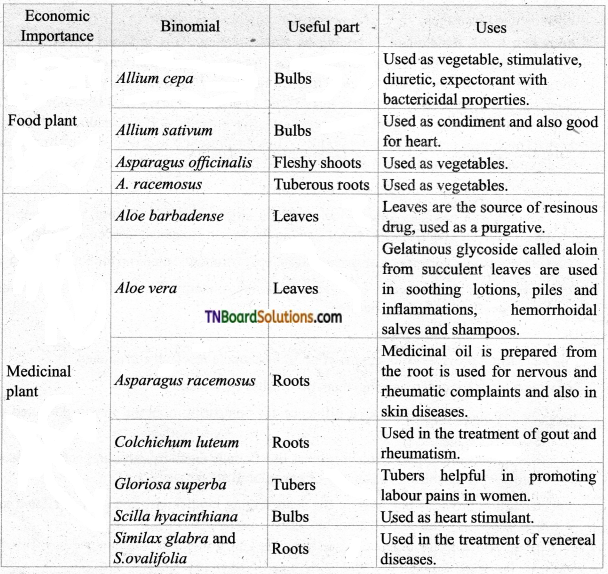
![]()
Question 19.
List any two ornamental plants under the family Fabaceae.
Answer:
Butea frondosa (Flame of the forest), Clitoria ternatea, Lathyrus odoratus (Sweet pea), and Lupinus hirsutus (Lupin).
Question 20.
What is meant by root module?
Answer:
Taproot system, roots are nodulated, have tubercles containing nitrogen-fixing bacteria (Rhizobium leguminosarum)
Answer In brief.
Question 1.
Explain the differences between taxonomy and systematics.
Answer:
| Taxonomy | Systematics |
| The discipline of classifying organisms into taxa. | The broad field of biology that studies the diversification of species. |
| Governs the practices of naming, describing, identifying, and specimen preservation. | Governs the evolutionary history and phylogenetic relationship in addition to taxonomy. |
| Classification + Nomenclature = Taxonomy | Taxonomy + Phylogeny = Systematics |
Question 2.
What is Botanical nomenclature? Explain the international code of botanical nomenclature.
Answer:
Assigning a name for a plant is known as Nomenclature. This is based on the rules and recommendations of the International Code of Botanical Nomenclature. ICB deals with the names of existing (living)and extinct (fossil) organisms. The elementary rule of the naming of the plant was first proposed by Linnaeus in 1737and 1751 in his Philosophia Botanica. In 1813 a detailed set of rules regarding plant nomenclature was given by A.P. de Candolle in his famous ‘ work “Theorie elementaire de la botanique”. Then the present ICBN was evolved by following the same rules of Linnaeus, A.P. de Candolle, and his son Alphonse de Candolle.
![]()
Question 3.
Mention any three roles of Botanical gardens.
Answer:
- Gardens with an aesthetic value attract a large number of visitors. For example, the Great Banyan Tree (Ficus benghalensis) in the Indian Botanical Garden at Kolkata.
- Gardens have a wide range of species and supply taxonomic material for botanical research.
- It can integrate information from diverse fields like Anatomy, Embryology, Phytochemistry, Cytology, Physiology, and Ecology.
Question 4.
List out the uses of the herbarium.
Answer:
- Herbarium provides resource material for systematic research and studies.
- It is a place for the orderly arrangement of voucher specimens.
- Voucher specimen serves as a reference for comparing doubtful newly collected fresh specimens.
- Voucher specimens play a role in studies like floristic diversity, environmental assessment, ecological mechanisms, and survey of unexplored areas.
- Herbarium provides an opportunity for documenting biodiversity and Studies related to the field Of ecology and conservation biology.
Question 5.
Explain Bentham and the hooker system of Glassification.
Answer:
- A widely followed natural system of classification Considered the best was proposed by two English botanists George Bentham (1800 – 1884) and Joseph Dalton Hooker (1817-1911).
- The classification was published in a three-volume work as “Genera Plantation”
(18624 883) describing 202 families and 7569 genera and 97,205 Species. - In this system, the seeded plants were classified into 3 major classes such as Dicotyledonae, Gymnospermae, and Monocotyledonae.
![]()
Question 6.
What do you know about karyotaxonomy?
Answer:
- Chromosomes are the carriers of genetic information. Increased knowledge about the chromosomes has been used for extensive biosystematic studies and resolving many taxonomic problems.
- Utilization of the characters and phenomena of cytology for the explanation of the taxonomic problems is known as cytotaxonomy or karyotaxonomy.
- The characters of chromosomes such as number, size, morphology, and behavior during meiosis have proved to be of taxonomic value.
Question 7.
What is RFLP? Explain briefly.
Answer:
RFLPs are a molecular method of genetic analysis that allows the identification of taxa based on unique patterns of restriction sites in specific regions of DNA. It refers to differences between taxa in restriction sites and therefore the lengths of fragments of DNA following cleavage with restriction enzymes.
Question 8.
What is the significance of molecular taxonomy?
Answer:
- It helps to identify a very large number of species of plants and animals by the use of conserved molecular sequences.
- Using DNA data evolutionary patterns of biodiversity are now investigated.
- DNA taxonomy plays a vital role in phytogeography, which ultimately helps in genome mapping and biodiversity conservation.
- DNA- based molecular markers used for designing DNA-based molecular probes, have also been developed under the branch of molecular systematics.
Question 9.
Write briefly about the diagnostic features of Solanaceae family.
Answer:
- Leaves alternate, exstipulate
- Flowers actinomorphic, pentamerous
- Calyx often persistence / accrescent
- Stamens 5, epipetalous, poricidal in dehiscence
- Carpels 2, ovary superior, 2 chambered, obliquely placed, falsely four-chambered placenta swollen, ovule numerous,
- Fruits berry or capsule, vascular bundles with both outer and inner phloem (Bicollateral vascular bundle)
![]()
Question 10.
Write down the floral formula of the following plants.
Answer:
- Datura metal,
- Solanum nigrum,
- Allium cepa.
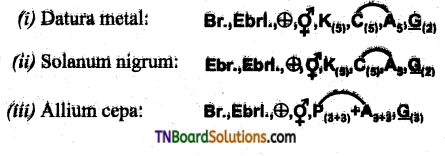
Answer In detail.
Question 1.
What is the concept of Species? Explain briefly the various concepts.
Answer:
Species are the fundamental unit of taxonomic classification. The Greek philosopher Plato proposed the concept of “eidos” or species and believed that all objects are shadows of the “eidos”. According to Stebbins (1977) species is the basic unit of the evolutionary process. A species is a group of individual organisms which have the following characters.
- A population of organisms that closely resemble each other more than the other population.
- They descend from a common ancestor.
- In sexually reproducing organisms, they interbreed freely in nature, producing fertile offspring.
- In asexually reproducing organisms, they are identified by their morphological resemblance.
- In the case of fossil organisms, they are identified by morphological and anatomical resemblance. Species concepts can be classified into two general groups. The concept emphasizing the process of evolution that maintains the species as a unit and that can result in evolutionary divergence and speciation. Another concept emphasizes the product of evolution in defining a species.
![]()
Question 2.
Describe the method of preparation of herbarium specimen.
Answer:
- Plant Collection: Plant specimen with flower or fruit is collected.
- Documentation of field site data: Certain data are to be recorded at the time of plant collection. It includes date, time, country, state, city, specific locality information, latitude, longitude, elevation, and landmark information. These data will be typed onto a herbarium label.
- Preparation of plant specimen: Plant specimen collected from the field is pressed immediately with the help of a portable field plant press. Plant specimen is transferred to a standard plant press (12” x 18”) which between two outer 12” * 18” frames and secured by two straps.
- Mounting herbarium specimen: The standard size of herbarium sheet is used for mounting the specimen (29cm x 41cm). specimens are affixed to herbarium sheet with standard white glue or solution of Methylcellulose.
- Herbarium label: Herbarium label size is generally 4-5” wide and 2-3” tall. A typical label contains all information like habit, habitat, vegetation type, landmark information, latitude, longitude, image document, collection number, date of collection, and name of the collector.
- Protection of herbarium sheets against mold and insects: Application of 2% Mercuric chloride, Naphthalene, DDT, carbon disulfide. Fumigation using formaldehyde. Presently deep freezing(-20°C) method is followed throughout the world.
Question 3.
Explain the basis of molecular taxonomy with its uses.
Answer:
- Molecular Taxonomy is the branch of phytogeny that analyses hereditary molecular differences, mainly in DNA sequences, to gain information and to establish genetic relationships between the members of different taxonomic categories.
- The advent of DNA cloning and sequencing methods has contributed immensely to the development of molecular taxonomy and population genetics over the years.
- These modern methods have revolutionized the field of molecular taxonomy and population genetics with improved analytical power and precision.
- The results of a molecular phylogenetic analysis are expressed in the form of a tree called a phylogenetic tree.
- Different molecular markers like allozymes, mitochondrial DNA, microsatellites, RFLP (Restriction Fragment Length Polymorphism), RAPD (Random amplified polymorphic DNA), AFLPs (Amplified Fragment Length Polymorphism), single nucleotide polymorphism-SNP, microchips, or arrays are used in the analysis.
Uses-of molecular taxonomy:
- Molecular taxonomy helps in establishing the relationship of different plant groups at the DNA level.
- It unlocks the treasure chest of information on the evolutionary history of organisms.
![]()
Question 4.
Write briefly about Cladistic analysis.
Answer:
- Cladistics is one of the primary methods of constructing phylogenies or evolutionary histories. Cladistics uses shared, derived characters to group organisms into clades.
- These clades have at least one shared derived character found in their most recent common ancestor that is not found in other groups hence they are considered more closely related to each other.
- These shared characters can be morphological such as, leaf, flower, Suit, seed, and so on; behavioral, like the opening of flowers nocturnal/diurnal; molecular like DNA or protein sequence, and more.
- Cladistic accepts only monophyletic groups. Paraphyletic and polyphyletic taxa are occasionally considered when such taxa conveniently treated as one group for practical purposes.
eg. dicots, Sterculiaceae. Polyphyletic groups are rejected by cladistic.
(a) Monophyletic group: Taxa comprising all the descendants of a common ancestor.
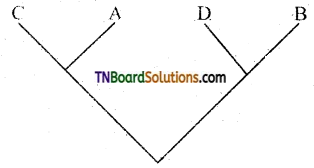
(b) Paraphyietic group: Taxon that includes an ancestor but not all of the descendants of that ancestor.
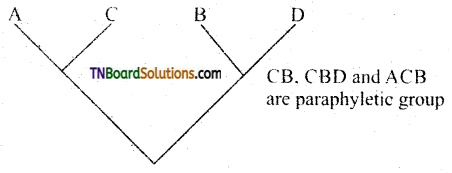
(c) Polyphyletic group: Taxa that includes members from two different lineages.

Need for Cladistics:
- Cladistics is now the most commonly used and accepted method for creating a phylogenetic system of classifications.
- Cladistics produces a hypothesis about the relationship of organisms to predict the morphological characteristics of organisms.
- Cladistics helps to elucidate the mechanism of evolution.
![]()
Question 5.
Explain the general characters of the family Solanaceae.
Answer:
- Distribution: Family Solanaceae includes about 88 genera and about 2650 species, of these Solanum, is the largest genus of the family with about 1500 species. Plants are worldwide in distribution but more abundant in South America.
- Habit: Mostly annual herbs, shrubs, small trees (Solanum violaceum) lianas with prickles (Solanum trilobatum) present in some taxa, many with stellate trichomes; rarely vines (Lycium, Sinensis)
- Root: Branched tap root system.
- Stem: Herbaceous or woody; erect or twining, or creeping; sometimes modified into tubers (Solanum tuberosum) often with collateral vascular bundles.
- Leaves: Alternate, simple, rarely pinnately compound (Solanum tuberosum and (Lycopersicon esculentum) exstipulate, opposite or sub-opposite in the upper part, unicostate reticulate venation.
- Inflorescence; Generally axillary or terminal cymose (Solanum) or solitary flowers (Datura stramonium). Extra axillary scorpioid cyme called rhiphidium (Solanum nigrum) solitary and axillary (Datura and Nicotiana) umbellate cyme (Withania somnifera).
- Flowers: Bracteate (Petunia), or ebracteate (Withania) pedicellate, bisexual, heterochlamydeous, actinomorphic, or weakly zygomorphic due to oblique position of ovary pentamerous, hypogynous. ,
- Calyx: Sepals 5, synsepalous, valvate, persistent rarely the sepals are 4 or 6. Often enlarging to envelop the fruit (Physalis, Withania).
- Corolla: Petals 5, sympetalous, rotate, tubular (Solanum) or bell-shaped (Atropa) or infundibuliform YPemwi’aj usually alternate with sepals; rarely bilipped and zygomorphic (Schizanthus) usually valvate, sometimes convolute (Datum).
- Androecium: Stamens 5, epipetalous, filaments usually Unequal in length, stamens only 2 in Schizanthus, 4 and didynamous in (Salpiglossis) Anthers dithecous, dehisce longitudinally or poricidal. …
- Gynoecium: Bicarpeliary, syncarpous obliquely placed, ovary superior, bilocular but looks tetralocular due to the formation of false septa, numerous ovules in each locule on axile placentation.
- Fruit: A capsule or berry. In Lycopersicon esculentum, Capsicum, the fruit is a berry and in species of Datura and Petunia, the fruit is a capsule.
- Seed: Endospermous.
Question 6.
Give the floral characters of Pisum sativum.
Answer:
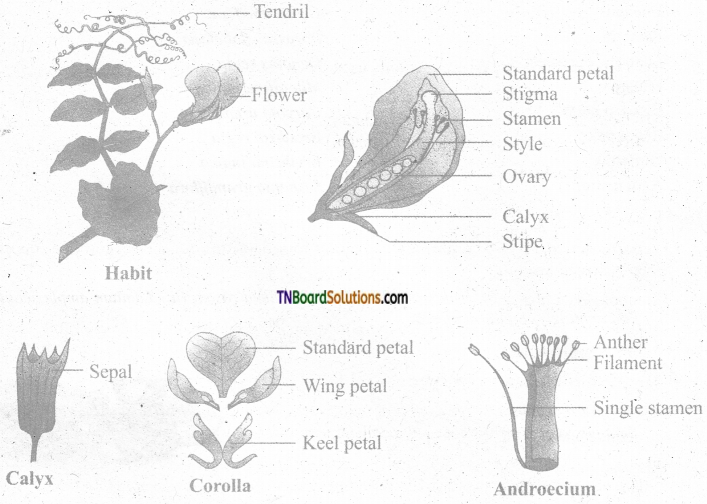
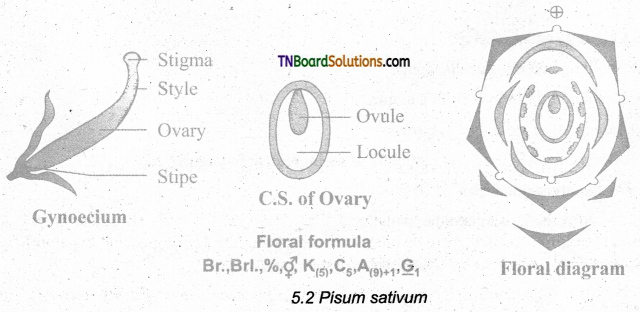
![]()
Activity
Text Book Page No. 128
Write common names and scientific names of 10 different plants around your home.
Answer:
| Common name | Scientific name |
| Neem tree | Azadirachta indica |
| Tamarind | Tamarindus indica |
| Coconut | Cocos nucifera |
| Palmyra | Borassusflabellifer |
| Flame of the forest | Delonix regia |
| Mango | Mangifera indica |
| Fishtail palm | Caryota urens |
| Royal palm | Bresdoxa regia |
| Gliricidia | Erythrina Indica |
| Agni maram | Sesbania grandiflora |
Text Book Page No,136
Prepare a herbarium of 5 common weed plants found inside your school campus /nearby garden/wasteland.
Answer:
Common weed plants: i) Tridax procumbence, (ii) Vinca rosea, (Hi) Lamium amplexicaula, . (iv) Poa annua, (v) Stellaria media.
Text Book Page No.160
Can you identify this?

(a) Name the family.
Answer:
Asparagales
(b) Write the binomial.
Answer:
Aloe vera.
![]()
(c) List the economic uses.
Answer:
(i) Cosmetic and medicine.
(ii) Soothing and moisturing agent.
(iii) Protection for human from sunburn.
(iv) Treatment of wounds and bums.
(v) Aloe vera gel is used commercially as an ingredient in yogurts.
(vi) As dietary supplement.
(vii) Skin treatment in Ayurvedic medicine.
Choose the correct answer.
1.18th International Botanical congress was held in 2011 at:
(a) London, U.K
(b) Melbourne, Australia
(c) Newyork, U.S.A
(d) Sydney, Australia
Answer:
(b) Melbourne, Australia
2. The lowest of classification is:
(a) Genus
(b) Kingdom
(c) species
(d) Family
Answer:
(c) species
3. Flora is the term used for:
(a) the document of all plant species.
(b) the document of single species in a given geographic area.
(c) the document of only endemic species of plants in a given area.
(d) none of the above.
Answer:
(a) the document of all plant species.
![]()
4. The first botanical garden was established by Theophrastus at:
(a) London
(b) Sydney
(c) Athens
(d) Singapore
Answer:
(c) Athens
5. Which is the largest Botanical garden in the world.
(a) Indian Botanical Garden, Kolkata, India
(b) Botanical Garden at Athens.
(c) National Botanical Garden, Lucknow, India
(d) Royal Botanical Garden Kew, England
Answer:
(d) Royal Botanical Garden Kew, England
6. Who was called as Father of Taxonomy?
(a) E.K. Janaki Ammal
(b) Carolus Linnaeus
(d) Theophrastus
(c) Heywood
Answer:
(b) Carolus Linnaeus
![]()
7. Plants with one stamen are grouped under:
(a) Tetrandria
(b) Diandria
(c) Monandria
(d) Pentandria
Answer:
(c) Monandria
8. The family coniferae is included under the class:
(a) Dicotyledonae
(b) Monocotyledonae
(c) Gymnospermae
(d) None of the above
Answer:
(c) Gymnospermae
9. Chemotaxomony is mainly based on:
(a) The chemical characters of the plant
(b) the morphological characters of the plant
(c) The phylogenetic characters of the plant
(b) none of the above
Answer:
(a) The chemical characters of the plant
10. The classification based on the characters of chromosome, such as number, size, morphology and behaviour during meiosis is known as:
(a) serotaxonomy
(b) Chemotaxonomy
(c) karyotaxonomy
(d) none of the above
Answer:
(c) karyotaxonomy
![]()
11. RAPD( Random amplified polymorphic DNA) is a method:
(a) to identify the morphomatic character of a plant
(b) to identify specific regions of DNA
(c) to identify genetic sequence of a plant
(d) to identify genetic markers using a randomly synthesised primer.
Answer:
(d) to identify genetic markers using a randomly synthesised primer.
12. Genetic sequence used to identify a plant is known as:
(a) DNA tags
(b) Polymorphic DNA
(c) Fragment of DNA
(d) Genome
Answer:
(a) DNA tags
13. Metformin used for treatment of diabetes is exacted from:
(a) Hibiscus rosasinensis
(b) Galega officinalis
(c) Arachis hypogea
(d) none of the above
Answer:
(b) Galega officinalis
![]()
14. Earlier classification emphasized on:
(a) Reproductive characters
(b) Vegetative characters
(c) both
(d) Anatomical characters
Answer:
(c) both
15. Naming a plant is called:
(a) systematic botany
(b) Taxonomy
(c) nomenclature
(d) Cytology
Answer:
(c) nomenclature
16. Bentham and Hooker’s classification is:
(a) Phylogenetic system of classification
(b) artificial system of classification
(c) natural system of classification
(d) sexual system of classification
Answer:
(c) natural system of classification
17. Carolus Linnaeus proposed classification based on:
(a) Artificial system
(b) natural system
(c) phylogenetic system
(d) modem system
Answer:
(a) Artificial system
18. The largest group of plant kingdom is
(a) Cryptogams
(b) Angiosperms
(c) Gymnosperms
(d) phanerogams
Answer:
(b) Angiosperms
19. Number of volumes in genera plantorum
(a) two
(b) three
(c) four
(d) five
Answer:
(b) three
![]()
20. The family gnetaceae is included under
(a) monochlamydae
(b) monotyledons
(c) dicotyledons
(d) Gymnosperms
Answer:
(d) Gymnosperms
21. Bentoam and Hooker are associated with
(a) Indian botanical garden
(b) Royal botanical garden
(c) American botanical garden
(d) French botanical garden
Answer:
(b) Royal botanical garden
22. The division of angiosperme is achieved by:
(a) floral characters
(b) anatomy
(c) physiology
(d) ecology
Answer:
(a) floral characters
![]()
23. Classification of plants into different groups is known as:
(a) Morphology
(b) Physiology
(c) Pathology
(d) Systematic botany
Answer:
(d) Systematic botany
24. Syngenesious anthers and epipetalous stamens are found in:
(a) Liliaceae
(b) malvaceae
(c) Solanaceae
(d) cruciferae.
Answer:
(d) cruciferae.
25. Synandrous condition is common in the family:
(a) Lumbelliferae
(b) Rosaceae
(c) malvaceae
(d) Cucurbitaceae
Answer:
(d) Cucurbitaceae
26. Polyadelphous condition is found in:
(a) Leguninaceae
(b) rutaceae
(c) compositae
(d) Liliaceae
Answer:
(b) rutaceae
![]()
27. Indefinite stamens are characteristic of the family:
(a) malvaceae
(b) graniceae
(c) labiatac
(d) cruciferae
Answer:
(a) malvaceae
28. Classical taxonomy is also termed as:
(a) B taxonomy
(b) systematics
(c) description and taxonomy
(d) experimental taxonomy
Answer:
(c) description and taxonomy
29. Match the following:
| (i) Pulses | (a) Cluster bean |
| (ii) Medicinal plants | (b) Arachis hypogea |
| (Hi) Food and plants | (c) Cowpea |
| (iv) Oil plants | (d) Mucunapruriens |
(a) (i)-(c), (ii)-(d), (iii)-(a), (iv)-(b)
(b) (i)-(d), (ii)-(c), (iii)-(a), (iv)-(b)
(c) (i)-(b), (ii)-(a), (iii)-(d), (iv)-(c)
(d) (i)-(b), (ii)-(c), (iii)-(a), (iv)-(d)
Answer:
(a) (i)-(c), (ii)-(d), (iii)-(a), (iv)-(b)
30. FAO declared the year for pulses as:
(a) 2017
(b) 2015
(c) 2018
(d) 2016
Answer:
(d) 2016